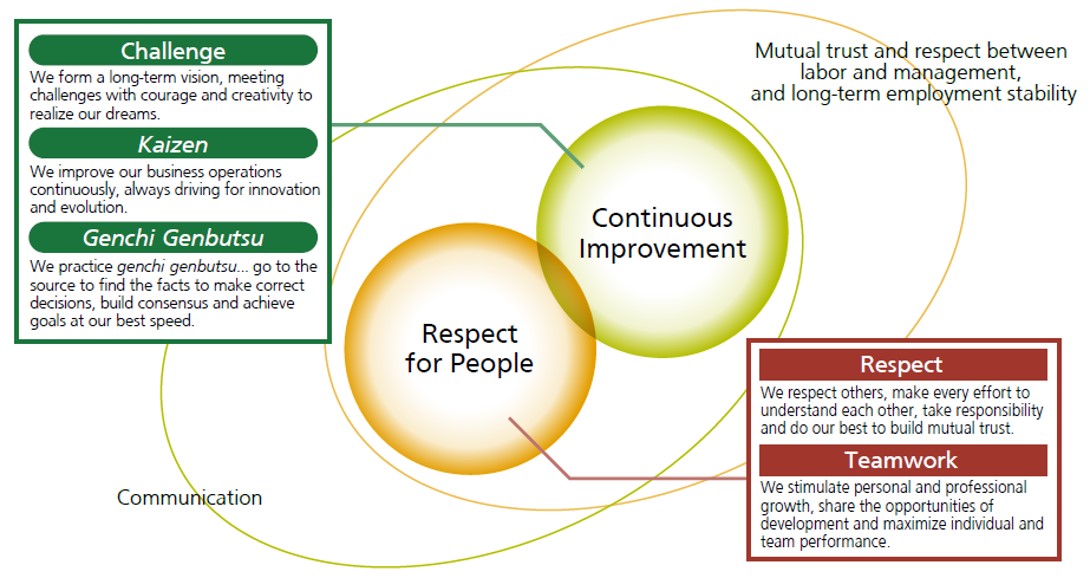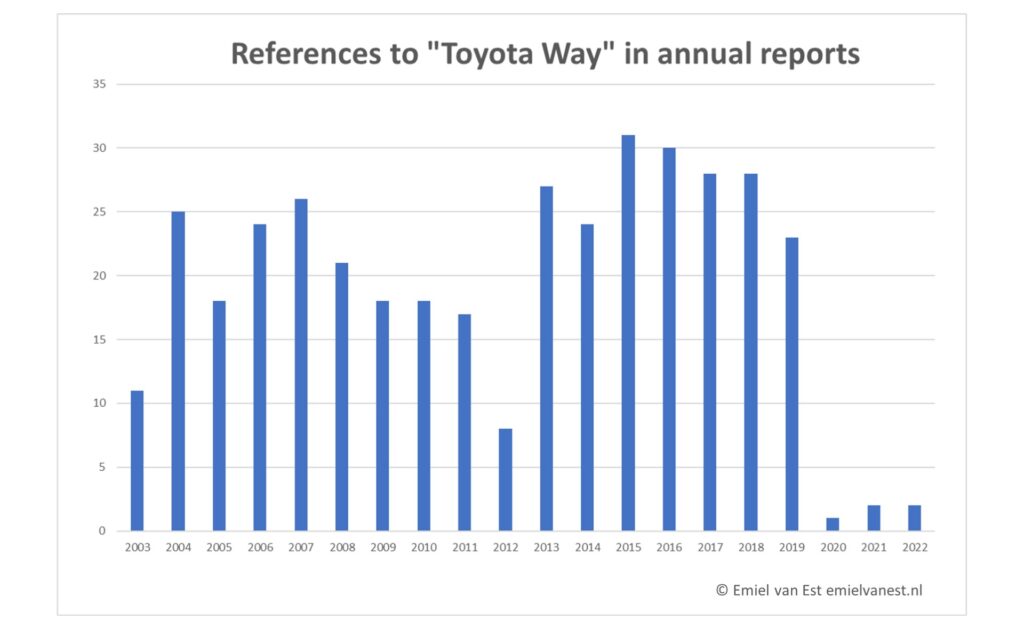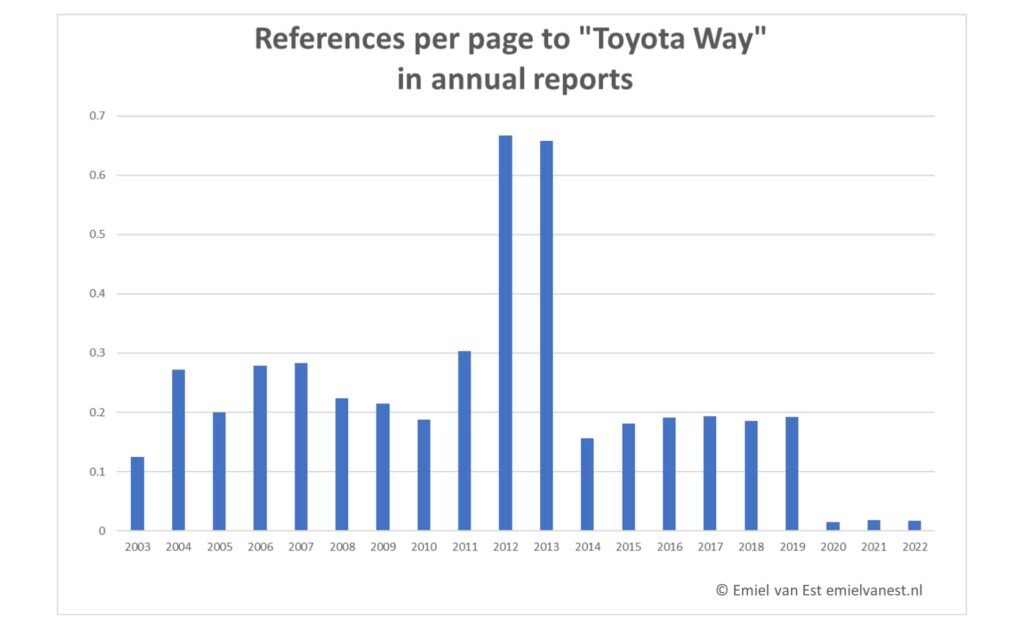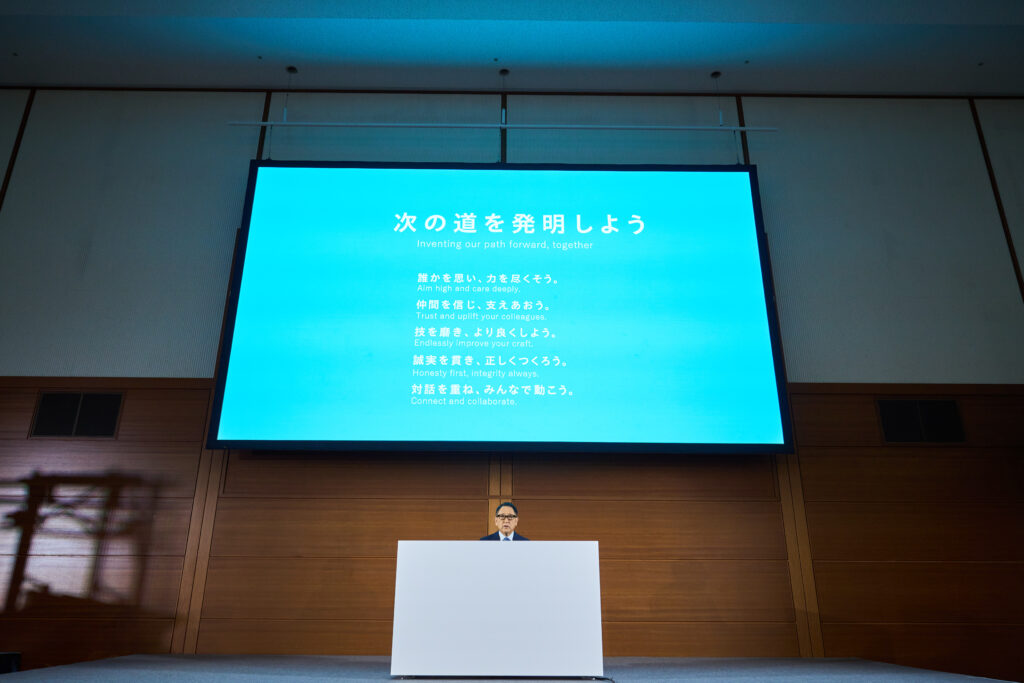In April 2001, after 10 years of drafting under the lead of Fujio Cho (CEO from 1999 to 2005) Toyota published The Toyota Way 2001:
“In this booklet we have identified and defined the company’s fundamental DNA, which summarizes the unique and outstanding elements of our company culture and succes.”
Fujio Cho’s introduction in The Toyota Way 2001
I studied this and related documents intensely. I think The Toyota Way 2001 is brilliant, a piece of art!
But now, 23 years later, Toyota is in serious trouble.
First cracks
Toyota pursued expansion of scale, prioritizing volume and profitability over the making of ever-better cars, and ultimately fell into the red for the first time in company history during the 2008 financial crisis.
Akio Toyoda
From 2009 through 2011, millions of vehicles were recalled due to issues with floormats and unintended acceleration.
Furthermore, due to global recalls, we lost the trust of our customers which is of the utmost importance to us.
Akio Toyoda
The first cracks in Toyota’s success story became visible.
Scandals
Now the cracks seem to burst open:
- 2019 Class action in Australia about faulty diesel particulate filters (DPFs) covering more than 264,000 Hilux, Fortuner, and Prado vehicles sold between October 2015 and April 2020.
- 2022 Hino, Toyota’s truck and bus unit, was caught falsifying engine data. It has said it falsified data on some engines going back as far as 2003. About 640,000 vehicles have been affected.
- 2023 Daihatsu, a Toyota-owned automaker, violated standards on crash tests and admitted to tampering with safety tests for 30 years.
- 2024 Toyota Industries Corp said it fabricated data on the torque output of diesel engines it makes and supplies to Toyota.
- 2024 Issues with air bag inflators produced by Takata in 2003-2004 Corolla, 2003-2004 Corolla Matrix, and 2004-2005 RAV4. In total more than 100 million products from over 20 carmakers are affected resulting in the biggest motor industry safety recall in history.

Nagoya, central Japan, Tuesday, Jan. 30, 2024. (Kyodo News via AP)
The Toyota Way
The Toyota Way was codified in 2001 to make the implicit teachings explicit to meet the teaching needs of Toyota’s globally expanding production and sales organizations:

Two pillars, 5 keywords, and a short definition as a summary of The Toyota Way 2001. It is brilliantly crafted and I can talk about it for hours, which I occasionally do in some masterclasses.
As said, I studied many documents related to The Toyota Way 2001, like Toyota’s annual reports. In the years following 2001, Toyota referenced its Way many times in these reports. Last year I searched in these reports how many times the phrase “Toyota Way” was used. This is what I found:

From 2003 till 2019, the annual reports talk about “Toyota Way” 22 times on average. From 2020 onwards that drops to just once or twice. How strange is that?
The size of these annual reports changed quite a bit over the years so I also tracked how many pages were used so I could calculate how many references per page were made:

From 2003 till 2019, the “Toyota Way” is referenced on average 0.26 times per page; about every 4th page. In 2012 and 2013 a big spike was found of about 0.66 times per page. That was right after the 2009-2011 recalls.
What happened in 2020?
In 2020 Toyota “updated” its Toyota Way.
The 2 pillars and 5 keywords were replaced with 10 phrases. A watered-down version, in my opinion, lacking the beauty, cohesion, and depth of the 2001 version.
A nice “one-pager” is also missing so I cannot show you what it looks like. You will have to look for yourself: https://global.toyota/en/company/vision-and-philosophy/toyotaway_code-of-conduct/
2024 A new vision? Again?
On January 30th, 2024 Akio Toyoda presented yet another vision for the Toyota group:

Vision
Inventing our path forward, together.
Attitudes
Aim high and care deeply.
Trust and uplift your colleagues.
Endlessly improve your craft.
Honesty first, integrity always.
Connect and collaborate.
The new vision showcases the uncertainty Toyota is currently facing. Nobody knows how bad it is gonna get.
I like that it has 5 attitudes, just like the 2001 version had 5 keywords. That is something one can count on the fingers of one hand and remember. However, the attitudes focus on the individual and their behavior. It feels angry and commanding, almost reproachfully.
It seems to me this 2024 vision is not the result of a decade of reflection. It feels more like the work of a few weeks in response to the eruption of the Daihatsu scandal in December.
Initially, the Group vision was to be shared on February 14, the birthday of Sakichi Toyoda. However, considering the recent situation of our Group companies, we have decided to bring the date forward and make an announcement to the media as well.
Akio Toyoda
Why not wait till February 14th to present the new vision as planned? It is just two weeks. These two weeks could have been used to investigate the most recent scandal at Toyota Industries Corp. in more detail. Why the rush? Too much pressure?
Maybe Toyota does not want to associate these scandals with the birthday of its founder. So, why mention it, creating the association anyway? Toyota seems to be in panic mode and is rushing.
First impressions
What triggers me in the recent scandals is the duration of the scams. Decades in both Hino and Daihatsu. Apparently, the distance between the top-floor of the Toyota Group and the shop-floor of these Toyota-owned companies was too big for proper Genchi Genbutsu.
And why the cheating? President of Toyota Motor, Koji Sato acknowledged that workers had felt pressure to cut corners in an intensely competitive industry.
We recognise that not only people at the testing site but also management did not have proper understanding of certification.
So, the pressure to deliver desired outcomes was too high. A sign of a toxic culture where Respect for People is missing.
Goalsetting may also have been disconnected from the reality of the shop-floor which might indicate inadequate Genchi Genbutsu as well.
Has Toyota lost its way? I hope not, but this is not looking good. Over the years, elements of The Toyota Way 2001 seem to have faded or have not been properly propagated, at least from the Group level to some of its 17 Toyota Group companies.